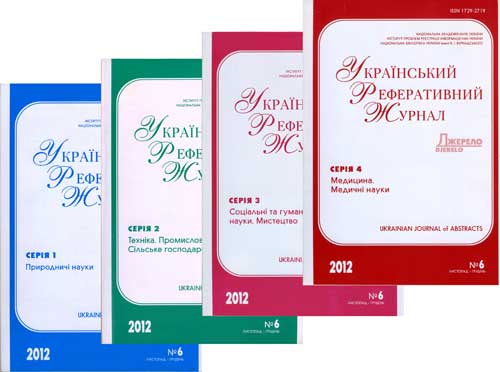РЕФЕРАТИВНА БАЗА ДАНИХ "УКРАЇНІКА НАУКОВА"
Abstract database «Ukrainica Scientific»
Бази даних
Реферативна база даних - результати пошуку
|
|
Пошуковий запит: (<.>ID=REF-0000743154<.>) | |||
|
Загальна кількість знайдених документів : 1 |
|||
Gzhegotskyi M. R. Lead, cadmium, copper and zinc content in women's blood during the third trimester of uncomplicated and complicated gestation / M. R. Gzhegotskyi, N. V. Sukhodolska // Експерим. та клініч. фізіологія і біохімія. - 2019. - № 3. - С. 5-11. - Бібліогр.: 16 назв. - англ. In this regard, the research of the heavy metals and trace elements effects on pregnancy by studying their content in womenіs blood during uncomplicated and complicated gestation is an important issue. The purpose of this study was to assess lead, cadmium, copper and zinc levels in womenіs blood during the third trimester of gestation and to analyze the correlation between their content and gestational complications. Investigation of lead, cadmium, copper and zinc levels in the blood of 45 women with uncomplicated pregnancy and 70 women with gestation complicated by anemia (31,4 %), threatened abortion (40,0 %) and gestational pyelonephritis (28,6 %) was carried out. The indication of metals was evaluated by the inversion voltammetry method. The following criteria were chosen: the third trimester of pregnancy, the homogeneity of social status, the absence of physical, genetic and oncological diseases, burdened obstetric and gynecological history. The course of pregnancy was analyzed by processing primary statistic documents - individual case records of pregnant and parturient women (form 111/o). The average level of lead and cadmium in womenіs blood during third trimester of complicated pregnancy were relatively higher (p << 0,01) than in women with the uncomplicated course of gestation, while the content of trace elements was significantly lower. The highest content of lead and cadmium were recorded in the blood of women with threatened miscarriage and pyelonephritis, which was 3,9 and 4,2 times higher (p << 0,01) than in uncomplicated pregnancy. Lead level in women with anemia and pyelonephritis exceeded the index in physiological gestation by 3,8 and 3,1 times (p << 0,01) respectively. Pregnant women with anemia and threatened miscarriage had respectively 3,0 and 3,9 times higher cadmium level (p << 0,01) than healthy ones. The average copper and zinc content during the third trimester of gestation was significantly in 1,3 - 1,8 times (p << 0,01) lower compared with uncomplicated pregnancy. The lowest levels of copper were found in the blood of pregnant women with anemia and the lowest zinc content і during threatened miscarriage. The lowest lead content (up to 0,08 mg/L) was combined with high (over 1,5 mg/L) copper concentration and did not depend on cadmium concentration in women. At the same time, high level of lead (over 0,56 mg/L) was observed in the case of increased cadmium content (over 0,005 mg/L) and decreased copper level (up to 0,08 mg/L). It was shown that combined effects of microelements such as cadmium and lead had provocative action on arising risk of gestational complications, whereas cooper and zinc had preventive action. In the third trimester of gestation, the development of threatened abortion was combined with high levels of lead and cadmium and low levels of zinc and copper, and the risk of anemia was correlated with a low concentration of copper and high content of lead in the blood of pregnant women and. At the same time increases the risk of pyelonephritis with high levels of cadmium and low in copper and zinc in the blood of pregnant women. Thus, adverse effects of elevated levels of lead and cadmium, low levels of copper and zinc on the clinical course of pregnancy were found. Індекс рубрикатора НБУВ: Р716.1 + Р716.2 + Р252.711.2 Рубрики: Шифр НБУВ: Ж16160 Пошук видання у каталогах НБУВ | |||
| Національна бібліотека України імені В. І. Вернадського |
 |
| Відділ наукового формування національних реферативних ресурсів |
 |
| Інститут проблем реєстрації інформації НАН України |
Всі права захищені © Національна бібліотека України імені В. І. Вернадського